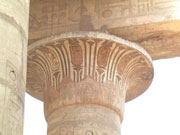NORTHERN SPAIN:
THE ANCIENT AND MEDIEVAL WORLD
THE ANCIENT AND MEDIEVAL WORLD

Barcelona cathedral
How�much�of�my�young�heart,�O�Spain,
Went�out�to�thee�in�days�of�yore!
What�dreams�romantic�filled�my�brain,
And�summoned�back�to�life�again
The�Paladins�of�Charlemagne,
The�Cid�Campeador!
And�shapes�more�shadowy�than�these,
In�the�dim�twilight�half�revealed;
Phoenician�galleys�on�the�seas,
The�Roman�camps�like�hives�of�bees,
The�Goth�uplifting�from�his�knees
Pelayo�on�his�shield.
It�was�these�memories�perchance,
From�annals�of�remotest�eld,
That�lent�the�colors�of�romance
To�every�trivial�circumstance,
And�changed�the�form�and�countenance
Of�all�that�I�beheld.
Old�towns,�whose�history�lies�hid
In�monkish�chronicle�or�rhyme,--
Burgos,�the�birthplace�of�the�Cid,
Zamora�and�Valladolid,
Toledo,�built�and�walled�amid
The�wars�of�Wamba's�time.
Henry Wadsworth Longfellow, 'Castles in Spain'
Went�out�to�thee�in�days�of�yore!
What�dreams�romantic�filled�my�brain,
And�summoned�back�to�life�again
The�Paladins�of�Charlemagne,
The�Cid�Campeador!
And�shapes�more�shadowy�than�these,
In�the�dim�twilight�half�revealed;
Phoenician�galleys�on�the�seas,
The�Roman�camps�like�hives�of�bees,
The�Goth�uplifting�from�his�knees
Pelayo�on�his�shield.
It�was�these�memories�perchance,
From�annals�of�remotest�eld,
That�lent�the�colors�of�romance
To�every�trivial�circumstance,
And�changed�the�form�and�countenance
Of�all�that�I�beheld.
Old�towns,�whose�history�lies�hid
In�monkish�chronicle�or�rhyme,--
Burgos,�the�birthplace�of�the�Cid,
Zamora�and�Valladolid,
Toledo,�built�and�walled�amid
The�wars�of�Wamba's�time.
Henry Wadsworth Longfellow, 'Castles in Spain'
THE TOUR
This three week study tour of northern Spain examines the rich cultural heritage of the region from ancient to medieval times. We begin the tour in Barcelona where we explore the Gothic quarter. We visit the archaeological excavations of the Roman city, the palace of the Kings of Aragon and the stunning Gothic Cathedral. We also visit the Sagrada Familia, a masterpiece of 20th Century architecture, and see the collection of Romanesque and Gothic art in the National Museum of Art. From Barcelona we take a day trip north to visit the ancient Greek and Roman site of Empuries, and explore the medieval town of Girona where we see the Gothic Cathedral and 12th Century Arab baths.
We then head to Tarragona where we explore the Roman ruins including a wonderful amphitheatre near the sea, the impressive walls and well preserved aqueduct. From here we continue to Zaragoza where we explore the Roman ruins of the ancient city. We also see the stunning Palace of Aljaferia, built by the city�s Muslim rulers in the 11th Century as well as the impressive Old Cathedral. The next day we head north to Olite where we explore the 14th century palace of King Carlos III of Navarre. We continue to Pamplona, where we walk around the old quarter of the town and see the Cathedral and the Museum.
Next we begin our drive along the medieval Pilgrim�s route known as the Camino de Santiago. We pass through scenic countryside visiting small villages to explore the Romanesque and Gothic monuments. We begin by driving to Eunate where we see a Romanesque Templar church. We then head to the town of Puenta la Reina with its famous medieval pilgrim�s bridge. A short walk along the Camino takes us to a Roman bridge. In Estella we explore the historic quarter including the Romanesque Church of San Pedro and the Church of San Miguel. The next morning we see the beautiful Irache Monastery, the Santa Maria Church in Los Arcos and in the town of Torres del Rio we see the beautiful Knights Templar Church of Santo Sepulchro. We head to the town of Logrono from where we visit the ancient Iberian and Roman site of Numantia.
The following day we drive north from Logrono to the Basque city of Bilbao where we explore the medieval heritage of the city in the Gothic quarter and visit the Cathedral. We also see the archaeological museum which includes Neanderthal remains. In the afternoon we see the famous Guggenheim Museum of Modern Art. From Bilbao we also take a day trip along the coast to Altamira where we see an impressive replica of the famous painted Cave from Palaeolithic times (the original cave has been closed since 1977). We also see the Museum of Altamira with its display of local finds and visit the nearby Castillo Cave with its Palaeolithic paintings.
Our journey next takes us south to the stunning medieval town of Burgos, once the capital of the Kingdom of Castile. We explore the old quarter and see the 13th Century Cathedral. We also visit the Monastery of Miraflores, the Museum of Human Evolution and see the beautiful 12th Century Monastery of Las Huelgas. A day is set aside for rest and relaxation in Burgos. Spend time exploring the stunning old quarter or simply rest and relax.
We continue our journey westwards stopping to see the 11th Century Romanesque Church of San Martin in Fromista. We also explore the splendid mosaics of the Olmeda Roman villa and stop to see the isolated Monastery of San Miguel Escalada which contains Visigothic elements.
Leon, ancient Roman legionary base and medieval capital of the Kingdom of Leon, will be our base for a few days. We see Leon's magnificent Gothic Cathedral with its magnificent 13th Century glass windows. We also visit the 11th Century Basilica of San Isidoro and the remarkable Royal Pantheon, burial place of eleven medieval rulers. The frescoes of the chapel are stunning. The next day we take a day trip to Oviedo, early medieval capital of Asturias. We pass through stunning mountainous country into the region of Asturias. Here we see the Gothic cathedral with its royal chapel. We also explore a number of 9th Century chapels and the royal hunting lodge known as Santa Maria del Naranco.
The following day we head west to Astorga where we see the Cathedral and the Archbishop's Palace designed by Antoni Gaudi. This contains an interesting collection of artworks associated with the medieval Pilgrimage. We then travel through the spectacular Cantabrian Mountains into Galicia. Our final destination is Santiago de Compostella, the end point for the Camino pilgrimage route. We visit the Cathedral, the interior of which mostly dates from the 10 and 11th Century. There is a chance to explore the medieval heritage of Santiago with last minute free time for shopping. The following day we fly back to Australia.
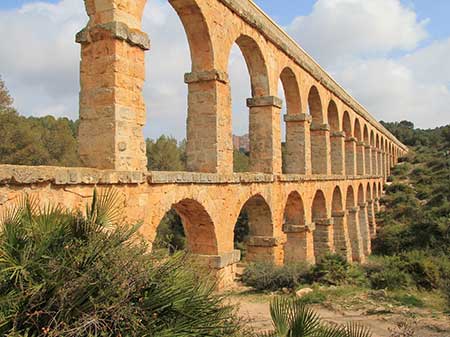
Tarragona aqueduct
ITINERARY*
Day 1: Depart AustraliaOur flight on Singapore Airlines leaves Australia with a stopover (usually 1-2 hours) in Singapore.
Day 2: Arrive Barcelona - walking tour of the Gothic Quarter
We arrive in Barcelona in the morning and check into our hotel. After freshening up we take a short walking tour of the Gothic Quarter of Barcelona. We start by visiting the Museum of the History of Barcelona. This has a fascinating display of the Roman houses which have been revealed underneath the buildings of the Renaissance Era. The visit then leads us through the palace of the Kings of Aragon which includes the beautiful 14th Century Chapel of St Agatha. We finish our walking tour with a visit to the Barcelona's splendid 13th Century Gothic Cathedral. Overnight Barcelona.
Day 3: Barcelona - Sagrada Familia church - National Museum of Catalunyan Art
In the morning we visit the famous Sagrada Familia church designed by Antoni Gaudi. One of the most famous examples of Art Nouveau, the church was unfinished when Gaudi died in 1926. The great building is still in the process of construction and is a wonder of modern design. After lunch we visit the National Art Museum of Catalunya where we see the stunning Romanesque and Gothic art from the local region. Overnight Barcelona.
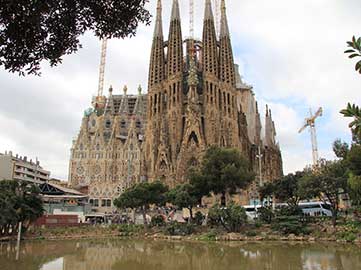 |
 |
The Sagrada Familia |
Stunning art in the National Art Museum |
Day 4: Empuries archaeological site - Girona
A day trip north of Barcelona takes us to the fascinating archaeological site of Empuries. This ancient city was founded by Greek colonists in the 6th Century BC and was enlarged by the Romans. The site is famous for its in-situ house mosaics and well preserved forum. In the afternoon we stop at Girona where we see the Gothic cathedral with its beautiful 12th Century Romanesque cloister. We also see the remarkably well preserved 12th Century 'Arab Baths'. Overnight Barcelona.
Day 5: Tarragona
In the morning we travel south to Tarragona. This was ancient Tarraco, an important Roman colony founded in 218 BC which later developed into a provincial capital. We explore the main archaeological sites including the famous amphitheatre near the sea, the town walls and the remarkably well preserved Roman aqueduct. In the afternoon we drive to Zaragoza where we check into our hotel. Overnight Zaragoza.
Day 6: Zaragoza
Today we explore the wonderful sights of medieval Zaragoza (the Roman city of 'Caesar Augustus'), once the Capital of the medieval Kingdom of Aragon. In the morning we see the spectacular 11th Century Islamic palace of Aljaferia. After lunch we explore the 17th Century Basilica de Nuestra Senora del Pilar and the impressive Cathedral which combines Gothic and Mudejar (Arabist) elements. We also visit the nearby forum of Caesar Augustus where we explore the ruins of the Roman theatre. Overnight Zaragoza.
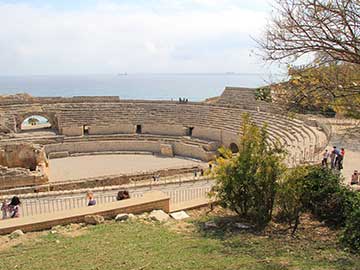 |
.jpg) |
Roman amphitheatre at Tarragona |
Aljaferia Palace in Zaragoza |
Day 7: Olite - Pamplona
In the morning we head north to the town of Olite where we explore the Royal Palace built in 1387 by King Carlos III of Navarre. The palace is a splendid example of non-religious Gothic architecture. We then head north to Pamplona, once the capital of the medieval Kingdom of Navarra. Pamplona was a Roman colony, founded and named after the general Pompey, and is famous for its medieval buildings and 'running of the bulls'. In the afternoon we take a walk in the old quarter and explore the 14th Century Cathedral in which Carlos III is buried. Overnight Pamplona.
Day 8: Pamplona Museum - Eunate - Puente la Reina
In the morning we see the impressive Museum of Navarre in the old quarter of Pamplona. Housed in an old pilgrim's hospital it houses a fascinating collection of artefacts from Roman and Muslim remains as well as stunning Gothic frescoes. After lunch we begin our drive along the Camino Pilgrimage Road. We head to Eunate where we see the unusual octagonal Romanesque church built by the Knights Templar. Nearby we explore the town of Puenta la Reina which is famous for its medieval bridge over the Rio Arga. We also see a Roman bridge near Cirauqui before heading to the town of Estella. Overnight Estella.
Day 9: Estella - free afternoon
The town of Estella was developed in the 11th Century and flourished due to its location on the Camino trail. We see the exterior of the royal palace (now an art gallery) and the fortified Church of San Pedro as well as the 12th Century Church of San Miguel with its impressive Romanesque sculpture. After lunch there is some free time to explore the old quarter of Estella or to rest and relax. Overnight Estella.
Day 10: Irache Monastery - Los Arcos - Torres del Rio
In the morning we drive along the Camino Trail to the Monastery of Irache, a beautiful medieval establishment (and sample the famous free 'wine fountain'!). We then head to the village of Los Arcos where we see the visit the church of Santa Maria. After lunch we visit Torres del Rio where we see the beautiful Romanesque chapel known as the Iglesia del Santo Sepulchro, probably built by the Knights Templar. Overnight Logrono.
Day 11: Numantia
In the morning we head south of Logrono through scenic mountainous country to the ancient site of Numantia. The site was inhabited by Celt-Iberians until besieged by the Romans under General Scipio. After its conquest the town was re-established as a Roman settlement. At the site we explore reconstructed ancient houses, Roman siege works and town walls. On our return to Logrono in the afternoon we take a walk through the old quarter and enjoy some excellent tapas. Overnight Logrono.
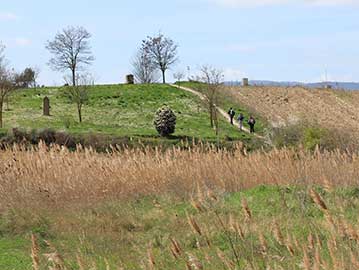 |
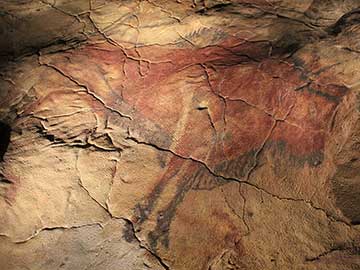 |
Pilgrims on the Camino Trail |
The Palaeolithic rock art at Altamira |
Day 12: Bilbao - old quarter - Guggenheim Museum (overnight Bilbao)
In the morning we head north of Logrono to the fascinating Basque city of Bilbao. On arrival we explore the old quarter. We see the small archaeological museum which includes Neanderthal remains and a 15th Century ship wreck. In the afternoon we visit the remarkable Guggenehim Museum of Modern Art, a Frank Gehry designed building of splendid originality. Overnight Bilbao.
Day 13: The Caves of Altamira - Museum of Altamira - Castillo cave
In the morning we take a scenic day trip from Bilbao westwards along the Biscay coast to Santillana del Mar where we visit Altamira. Famous for its Palaeolithic cave decorated with scenes of bison and other animals, the real caves were closed in 1977 and we see an impressive replica. We tour the Museum of Altamira which has a display of early human evolution. On our return to Bilbao we stop to see the Castillo Cave, a prehistoric cave with beautiful rock art. Overnight Bilbao.
Day 14: Burgos - Burgos old quarter - Miraflores Monastery
In the morning we head south to the beautiful city of Burgos, medieval Capital of the Kingdom of Castile for almost 500 years. We go for a walk in the old quarter where we see the superb 13th Century Gothic Cathedral and its many chapels (and tomb of El Cid). The Cathedral was begun by King Fernando III and is one of the outstanding examples of the Gothic style. In the afternoon we explore the beautiful Carthusian Miraflores Monastery. Overnight Burgos.
Day 15: Free day in Burgos
The day is set aside to rest and relax in Burgos. There are many opportunities to explore the medieval heritage of this stunning town or simply read a book and have a quiet time. Overnight Burgos.
Day 16: Burgos Museum of Human Evolution - Monastery of Las Huelgas
In the morning we see the Museum of Human Evolution which houses important fossil finds and archaeological evidence from the local area. Highlights are the remains of Homo antecessor from the nearby site of Atapuerca, the earliest human remains found in Europe. In the afternoon we visit the stunning Royal Monastery of Las Huelgas founded in 1187 by Alphonso VIII. It contains many royal burials and a museum displaying artefacts found with the royal bodies. Overnight Burgos.
 |
 |
Monastery of Irache |
Walking in Burgos |
Day 17: Fromista - Olmeda Roman villa - San Miguel Monastery
In the morning we head west to the town of Fromista. Here we see the Church of San Martin which was originally part of an abbey. This 11th Century Church was built in Romanesque style with elaborately carved figures on the exterior. We then continue to the Olmeda Roman villa. This important site preserves over 1000 square m of impressive ancient Roman mosaics in-situ. In the afternoon we stop at the Monastery of San Miguel Escalada, a very early church which preserves Visigothic elements. Overnight Leon.
Day 18: Leon
The day is set aside to explore the ancient city of Leon. Established as a Roman legionary camp (from which it gets its name), it became the early medieval capital of the Kingdom of Leon. In the morning we see the Roman walls of the city and the 11th Century Basilica of San Isidoro, built by King Fernando I as a shrine for the bones of the saint. Adjoining the basilica is the lavishly frescoed Royal Pantheon, burial place of eleven medieaval kings. In the afternoon we explore the magnificent Gothic Cathedral with its famous 13th Century stained glass windows. Overnight Leon.
Day 19: Oviedo
This day trip takes us north of Leon to explore the architectural heritage of the ancient city of Oviedo, early medieval capital of the Kingdom of Asturias. Our road takes us through the beautiful Cantabrian mountains. In Oviedo we explore examples of pre-Romanesque architecture including the 9th Century Church of San Julian de los Prados, the Church of Santa Maria del Naranco (built as a hunting lodge around AD 850), and the Church of San Miguel de Lillo, also from the 9th Century. In the afternoon we explore Oviedo�s beautiful Gothic Cathedral. Overnight Leon.
Day 20: Astorga
In the morning we drive west from Leon to Astorga, an important ancient Roman city which still preserves its ancient walls. We explore the 15th Century Astorga Cathedral and the nearby Palacio de Gaudi, a whimsical palace built by Antoni Gaudi for the local archbishop in Neo-Gothic style. The house contains a Museum of the Camino Trail with art objects related to the pilgrimage. In the afternoon we have a scenic drive through the Cantabrian Mountains into Galicia and onwards to Santiago de Compostella. We go for a walk in the old quarter. Overnight Santiago.
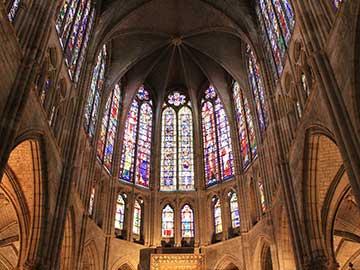 |
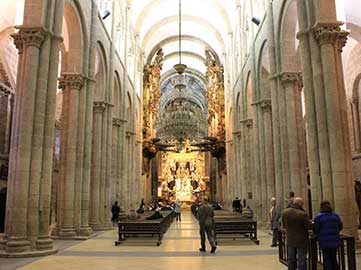 |
Gothic Cathedral of Leon |
Santiago Cathedral |
Day 21: Santiago de Compostella
The morning is devoted to exploring the medieval heritage of Santiago de Compostella. We visit the stunning Cathedral of Santiago, the main body of which is Romanesque in style and dates from the 11th Century. This is one of Galicia's grandest monuments and the final destination for medieval pilgrims walking the Camino Trail. We then wander through the Old Quarter of the city. In the afternoon we fly to Barcelona. Overnight Barcelona.
Day 22: Fly to Australia
In the morning we fly from Barcelona International Airport on our Singapore Airlines flight to Australia.
Day 23: Arrive back in Australia
We arrive back in Australia in the late afternoon.
* Please note that the Company reserves the right to make alterations to the itinerary in the period up to 60 days prior to a tour departure. The itinerary may also be subject to minor re-arrangement due to the scheduling of the operators and availability of access. If this occurs, the Company will endeavour to provide a comparable alternative.
